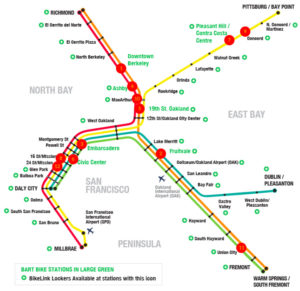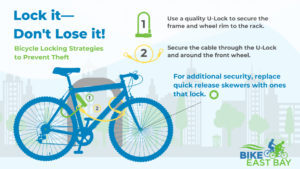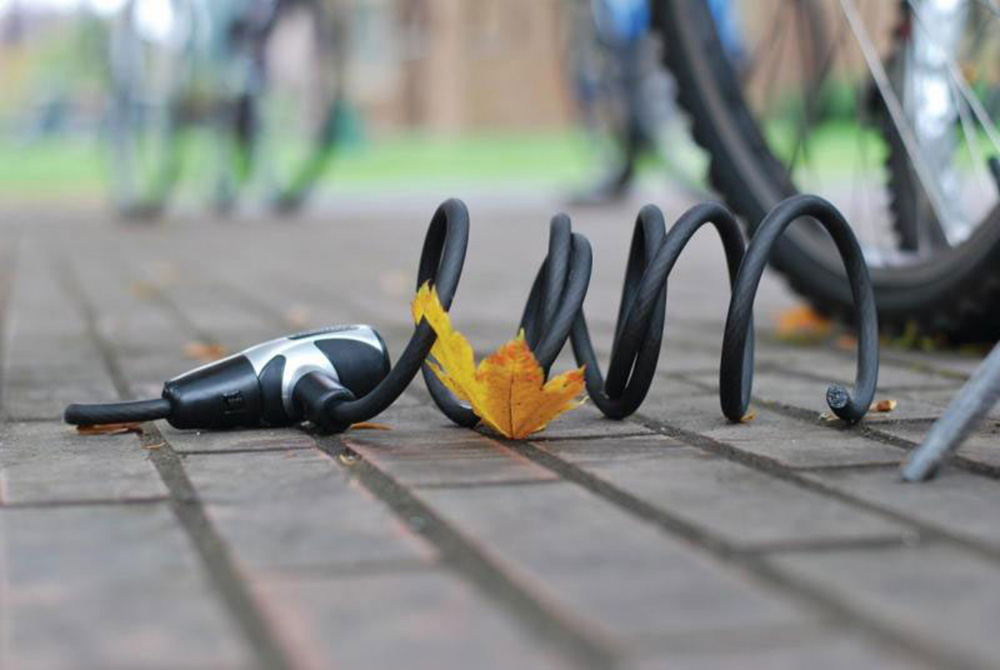Bicycle theft is a big problem in the Bay Area, but with a few precautions you can reduce the chance of someone making off with your property.
- Step 1: Register Your Bike
- Step 2: Use a Quality Lock
- Step 3: Know Where to Lock
- Step 4: Know How to Lock
- Step 5: Your Bike Was Stolen Anyway
Step 1: Register Your Bike
Register your bicycle for free at BikeEastBay.org/register. Having registration info on file means that you will be able to make a police report if your bicycle is stolen, and it allows you to flag it as stolen so that anyone who finds it can let you know. Individuals can even Google search your bike’s serial number to find out if it is listed as stolen or not
In addition to registering your bike online, you can also:
- Write down your bicycle’s serial number, make, model, color, and other distinguishing characteristics, and keep this info in a safe location.
- Take photos of your bicycle. This will come in handy if you have to describe your bicycle to the authorities and spread the word about a theft.
- Etch your driver’s license/ID number into the bike frame, or write your contact info on a rolled up piece of paper inside the handlebar or seat tube where a thief is unlikely to look.
Over 80% of bikes stolen from BART stations were secured using only a cable lock, which by itself can be cut using shears in just a few seconds.
Instead, use a high-quality U-lock designed for bicycles or motorcycles. Used a keyed lock, not a combination. A quality lock will likely cost $40 or more, with the level of security usually proportional to the price.
This guide lists of features to look for when purchasing a U-lock
A feature comparison of top U-lock brands: ABUS, Kryptonite, and OnGuard
In addition, we recommend:
- A second U-lock, chain, or cable to make sure the frame and both wheels are secured.
- Locking skewers to secure the wheels to the frame.
- An additional chain or cable lock to secure the bike seat to the frame.
- Keeping your U-lock clean and working smoothly by applying some bike chain lubricant into the keyhole and lock mechanism once every couple of months, or anytime your lock has been left out in the rain.
- Take easily removable items with you when you park your bike. This includes lights, bags, bottles, your helmet, etc.
Talk to an employee at your local bike shop about these and other bike security options, including GPS or cell-enabled electronic bike trackers that are starting to come onto the market.
Step 3: Know Where to Lock Safely (Not Outside Overnight)
About 20% of bikes stolen from BART stations were locked up outside overnight.
If you must leave your bike out overnight, use one of the inexpensive BikeLink lockers or rooms available at BART stations and other East Bay locations for only 5¢ per hour.
Purchase a $20 BikeLink card which will get you access to all of these secure facilities, with more being added every year.
Some BART stations provide free valet bike parking, and others have BikeLink card-accessed rooms and lockers. Click on this map for info, then watch the video below for details about secure bike parking at BART.

The rest of the time remember to:
- Lock your bike to a solid, metal object (not a chainlink fence, tree, or wooden railing). Make sure your bike isn’t blocking a sidewalk, curb ramp, or railing.
- Use a bike rack. If none are available then permanent metal poles or parking meters work, if they have a top that your bike and lock and just not be lifted over, and bolts that can not be easily removed.
- Shake the bike rack, pole, or parking meter to ensure that it is secured to the ground.
If there are not enough bike racks available, contact the city to request more. Oakland, for instance, has an online bike rack request form that you can fill out here.
To avoid bike theft at home and the workplace we recommend that you:
- Lock securely to nonmoveable metal fixtures if storing your bikes in a garage or shed.
- Don’t store your bike outside in a yard or commons space.
- Find out if bike theft is covered in your home owner’s or renter’s insurance policy. Make sure you know if coverage applies for bikes stored indoors, in garages, in bike rooms, or elsewhere.
- Ask your building manager or landlord to provide a secure bike room, if you live in an apartment. If there is one then use it, but still U-lock your bike securely.
Step 4: Know How to Lock Safely
While no lock can offer 100% security, employ a locking strategy that has “layers of security” which make your bike less convenient to target.
Every locking strategy should at the very least secure the frame and rear wheel directly to the rack, with the front wheel secured to the frame or rack. Here are a few options for doing so:

Alternately, you can use two U-locks: one for the front wheel and one through the rear triangle of your frame that also secures your rear wheel. The lock should encircle the rim and not just the spokes of the wheel.
Step 5: Your Bike Was Stolen Anyway
Sometimes, despite our best efforts, a thief still makes off with a bike. Here are some tips you can use to recover your bike:
- First Step: File a police report. Stolen bicycles are recovered often, but without documentation they can’t be returned to their owners. Reports also help cities to better know how to allocate resources and where to install secure bike parking facilities.
- Visit local flea markets to look for your bike right away. These include:
- Post your bike’s info here:
- List and flag your bike as stolen, via the free BikeIndex database. BikeIndex also auto-posts to Twitter.
- Scan local Craigslist and eBay listings for your bike, using Google alerts or another automated search tool. This can yield results even months after the theft.
If you find your bike we do not recommend confronting the seller yourself. Instead, ask the flea market security or police for assistance, and bring a photo of your bike or your online registration as proof of ownership to reclaim your property. The seller may not the person who stole your bike originally, but they still have no claim to the property and do not require compensation.
Additional Resources
Want to learn more? Sign up for one of our FREE education and skills classes at BikeEastBay.org/education.


